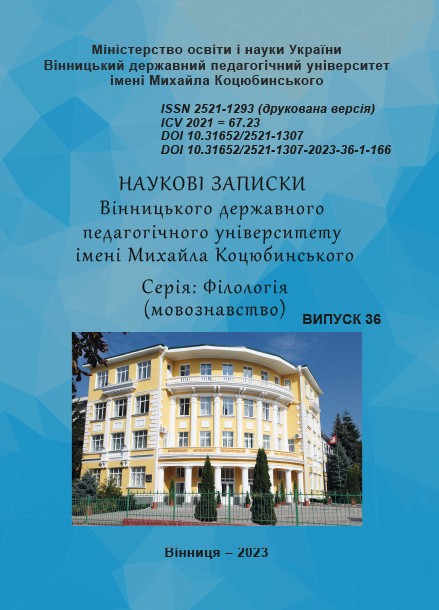Apperception and association at reader verification of the poetic image
https://doi.org/10.31652/2521-1307-2022-36-61-70Published 2023-06-21
Keywords
- apperception, association, interpretation of a poetic text, verification of a verbal image, linguistic awareness, language mentality, Oleksandr Potebnya, Serhiy Zhadan
Copyright (c) 2023 Olena Malenko

This work is licensed under a Creative Commons Attribution 4.0 International License.
How to Cite
Abstract
Introduction. The article presents a study of the phenomenon of apperception. Scientists understand apperception as the perception of information through human experience, its ideas, images, assessments. Apperception is an important mechanism for interpreting the content of an artistic text and verifying a verbal image. A linguistic interpretation of the philosophical understanding of apperception was proposed by Oleksandr Potebnya in his work «Thought and Language» (1862), adapting this term to the needs of scientific understanding of language as a result of the spiritual and linguistic creative activity of a person. The problem of individual decoding of the meanings of the artistic word and text through the prism of acquired experience (apperception), described at one time by Potebnya, was further elaborated in the works of modern Ukrainian and foreign scientists and now attracts researchers who study the functioning of language in the anthropocentrism paradigm. The article is relevant because it touches on the issues of anthropocentric linguistics, in particular the individual reception of the text by the reader.
Purpose. The purpose of the article is to scientifically comment on the apperceptive and associative potential of paradigmatic and syntagmatic models in the processes of verification of the poetic text in general and the image in particular by recipients of different statuses.
Methods. Research methods: functional; conceptual analysis, method of distributive analysis.
Results. The linguistic material of the study was a poem by the famous Ukrainian poet Serhiy Zhadan, which depicts the image of la femme fatale. The study proved that recipients of different ages and experience verified this image in different ways. Students and teachers from the field of philology were involved in the experiment. The discrepancy in the verification of the image of la femme fatale was revealed at the level of reactions and associations to the word flask. Young recipients associated this word with alcohol as a harmful factor. That is, the woman depicted by the poet appears in their verification as vicious, drinking. Disapproving reactions to the image are strengthened by paradigmatic and syntagmatic models, the lexical support of which are the words portwine, rage, smoke, strike, kill. For the sake of a woman, the hero is ready to burn down houses, go on strike, and kill all poets. If only this woman would pay attention to him. Instead, the recipients of the adult group recognized this woman as driven, independent and self-sufficient.
Originality. Such a different reaction to the word flask is due to individual experience, individual ideas and reactions to the stimulus word. The originality of this article is due to the extrapolation of the theoretical provisions of Oleksandr Potebnya and other Ukrainian linguists in the study of the receptive potential of Serhiy Zhadan's text. Also, originality is due to the implementation of an experiment regarding the perception of content and image by specific readers.
Conclusion. The anthropocentric character of modern studies on linguopoetics, on the study and understanding of the artistic text actualizes the aesthetic communication of the author – the text – the reader. This has prospects for learning the cognitive mechanisms of the formation of a competent reader. This reader is able to harmonize with the author, understand his intention and decode the author's meanings.
Downloads
References
- Великий тлумачний словник сучасної української мови. Київ; Ірпінь : ВТФ «Перун», 2009.
- Воробйова О. Когнітивна поетика в Україні: напрями досліджень. Актуальні проблеми романо-германської філології в Україні та Болонський процес: Матеріали Міжнародної наукової конференції. Чернівці : Чернівецький нац. ун-т імені Юрія Федьковича, 2004. С. 37–38.
- Маленко О. О. Лінгвопоетика як науковий досвід: питання методології і методів лінгвістичного аналізу художньої мови. Лінгвістичні дослідження: Зб. наук. праць ХНПУ імені Г.С. Сковороди. Випуск 54, т.2 . Харків : ХНПУ імені Г.С. Сковороди, 2021. С. 99–111. https://doi.org/10.34142/23127546.2021.54.2.10
- Мойсієнко А.К. Слово в апперцепційній системі поетичного тексту : Декодування Шевченкового вірша. Київ, 2006. 304 с.
- Муранець Т. Портрет фатальної жінки в прозі Івана Франка. Вісник Львівського університету. Серія філологічна. 2013. Випуск 58. С. 82–97.
- Потебня А. А. Из записок по теории словесности: Поэзия и проза. Тропы и фигуры. Мышление поэтическое и мифическое. Харьков, 1905. 625 с.
- Потебня А. А. Мысль и язык. Киев : СИНТО, 1993. 191 с.
- Словник української мови : в 11 томах. Том 4. Київ, 1973. 640 с.
- Філософський енциклопедичний словник. Київ : Абрис, 2002. С. 35–36.





